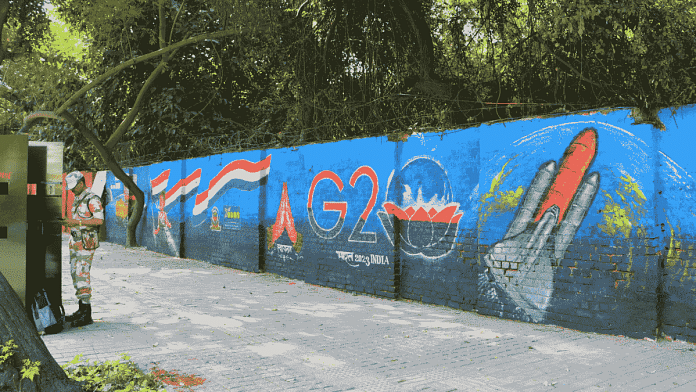New Delhi: Colourful murals proudly celebrating the success of India’s Chandrayaan-3’s moon mission ahead of the G20 Summit depict a rather hilarious, but unfortunate faux pas. Instead of India’s Launch Vehicle Mk III, on which the lunar vessel was launched, at least two murals have showcased NASA’s retired Space Shuttle.
The murals, commissioned by the Municipal Corporation of Delhi (MCD), are displayed on walls near Vinobapuri Metro station, and along a garbage dump yard in the Nizamuddin area.
“To err is human. The idea was to depict the sentiment behind the success of the Chandrayaan 3 launch. These works are commissioned to artists and student volunteers, who have complete freedom to express themselves,” said a senior MCD official on the condition of anonymity.
“If they made NASA rockets by mistake, perhaps we can take this in the spirit of Vasudhaiva Kutumbakam,” he added with a laugh.
The official was making a reference to India’s G20 theme of Vasudhaiva Kutumbakam— One Earth. One Family. One Future. Vasudhaiva Kutumbakam is a Sanskrit phrase that means “the world is one family”.
The rockets depicted on the murals closely resemble the NASA Space Shuttle, which carried out several launches between 1981 and 2011. According to NASA’s website, between the first launch on 12 April, 1981, and the final landing on 21 July, 2011, this space shuttle fleet — Columbia, Challenger, Discovery, Atlantis and Endeavour — flew 135 missions and helped construct the International Space Station.
Also Read: Chandrayaan-3 shows more than just ISRO’s excellence. It’s the STEM catalyst India needed
‘Disparity in outreach’
NASA’s Space Shuttle consisted of multiple components, with the most recognisable being the orbiter with a sleek and airplane-like appearance. It was used to carry astronauts and cargo into space, perform a variety of missions, and then return to Earth for landing.
On the other hand, the Launch Vehicle Mk III — previously known as GSLV Mk III — has been developed by ISRO in India. While it does not have a space shuttle, the payload sits on a module on the top of the rocket.
The senior MCD official quoted earlier did not share the identity of the artists who were commissioned these murals, but conceded there could have been oversight on the part of the municipal officials.
But its spirit was to celebrate the success of Chandrayaan-3, he added.
However, according to Aniket Sule, an astrophysicist and associate professor at Tata Institute of Fundamental Research’s Homi Bhabha Centre For Science Education, the error points to a deeper problem. According to him, what it shows is the difference in quality of publicity and outreach between the two space agencies.
“NASA does a much better job of popularising its content and missions. Its images, graphics etc are very readily available on their website as well as the outreach centre,” he said. “In the US, you will see every other student with NASA jersey, and stickers. As a result, their rockets stick to public memory.”
On the other hand, ISRO has a long way to go when it comes to outreach, Sule said. “The Chandrayaan-3 and Aditya L1 missions were the first time that we saw ISRO being ready with good-quality outreach materials. Before that, they used to share materials on social media only as an afterthought,” he said.
Both NASA and ISRO are currently planning human missions to space — Artemis in NASA’s case and Gaganyaan for ISRO.
Artemis is a robotic and human Moon exploration programme that NASA is planning in collaboration with six major partner agencies— the European Space Agency (ESA), the German Aerospace Center (DLR), the Japan Aerospace Exploration Agency (JAXA), the Canadian Space Agency (CSA), the Israel Space Agency (ISA), and the Italian Space Agency (ASI).
On the other hand, ISRO envisions sending three astronauts to low Earth orbit through Gaganyaan.
Sule points to the difference in materials available online for these two missions. “Even for outreach on the Gaganyaan mission, people use Artemis cutouts because those are so easily available,” he said.
(Edited by Uttara Ramaswamy)
Also Read: ‘India don dey Moon now’: How world media reported Chandrayaan-3, from Pidgin to Queen’s English



